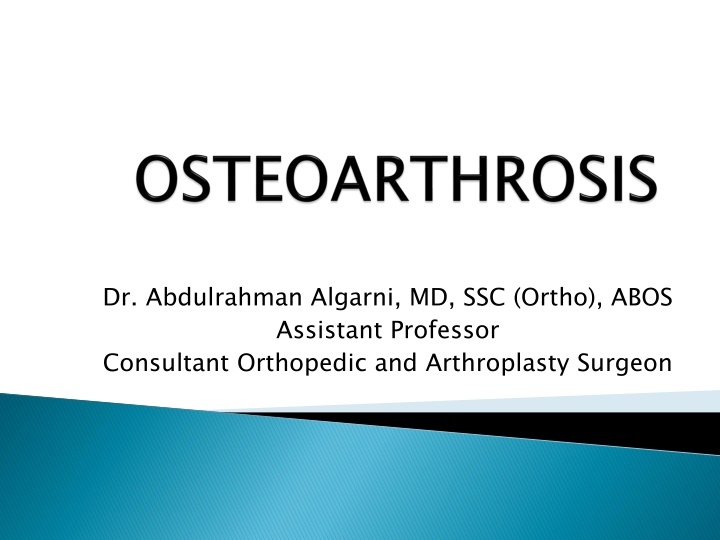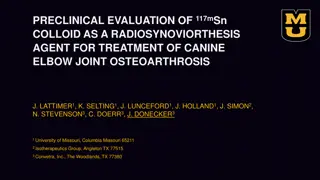
Non-Inflammatory Degenerative Joint Disease
Explore the complexities of non-inflammatory degenerative joint disease, covering primary and secondary causes, risk factors, common presentations, and pathophysiology. Learn about the impact of increased load, necrosis, metabolic issues, and other factors on joint health, as well as attempts at repair mechanisms. Gain insights into this prevalent condition affecting weight-bearing joints like the knees, hips, spine, and more.
Download Presentation

Please find below an Image/Link to download the presentation.
The content on the website is provided AS IS for your information and personal use only. It may not be sold, licensed, or shared on other websites without obtaining consent from the author. If you encounter any issues during the download, it is possible that the publisher has removed the file from their server.
You are allowed to download the files provided on this website for personal or commercial use, subject to the condition that they are used lawfully. All files are the property of their respective owners.
The content on the website is provided AS IS for your information and personal use only. It may not be sold, licensed, or shared on other websites without obtaining consent from the author.
E N D
Presentation Transcript
Dr. Abdulrahman Algarni, MD, SSC (Ortho), ABOS Assistant Professor Consultant Orthopedic and Arthroplasty Surgeon
A non-inflammatory (Degenerative) disease affecting articular cartilage of joints
Primary Intrinsic defect (mechanical, vascular, cartilage, hereditary-generalized O.A) Secondary Secondary to local or systemic disease
Increased load: obesity(hips and knees take 3-4 body weight with each step) Trauma: osteochondral, malunion, sport injury Congenital/developmental: CDH, multiple epiphyseal dysplasia Infection
Necrosis: Perths disease, osteonecrosis, steroids Hematologic: SCD, hemophelia Endocrine: DM, acromegaly
Metabolic: crystaline deposition disease(gout, CPPD), Paget s disease Inflammatory: RA, SLE, Reiter s syndrome Neuropathic: DM, tabes dorsalis
Common in our community esp. knees Much more in females ;esp. obese Presents earlier than in West About 90% of those over 40 have asymptomatic degeneration of weight bearing joints Commonest joints are knee, hip, C-Spine & L-Spine,1stCMJ,1stMTPJ and IPJ
Increased water content: swelling and softening of cartilage Depletion of Proteoglycans Chondrocyte damage and synovitis proteolytic enzymes collagen disruption Fibrillation on weight bearing surfaces Loss of cartilage height and exposed bone Decreased joint space
Attempts of repair: SUBCHONDRAL SCLEROSIS eburnation (ivory-like bone) Fissuring (cracks): synovial fluid pumped into subchondral bone SUBCHONDRAL CYST Hypervascularity of synovium and subchondral bone proliferation of adjacent cartilage enchondral ossification OSTEOPHYTE
Osteophytes and eburnation fissuring
Synovial and capsular thickening Progressive bone erosion BONE COLLAPSE Fragmented osteophyte LOOSE BODIES Loss of height and ligamentous laxity MALALIGNMENT
SYMPTOMS Pain, inability to bear weight, stiffness, limping, deformity, instability SIGNS Effusion, Swelling, tenderness, crepitus, deformity-malalignment
X-ray (STANDING in lower limb) Loss of space Sclerosis Cysts Osteophytes Loose bodies Malalignment Subluxation synovial analysis (in differential diagnosis)
History Examination Investigations
Decrease load (stick, brace, reduce weight) Modify activity Physiotherapy: prevent contractures muscle strengthening range of motion Medications systemic local
Joint Debridement Joint Debridement Corrective Corrective Osteotomy Osteotomy What? varus/valgus, abd./add. Why? realign axis and redistribute weight
Which joint? knee/hip What joint? mobile, stable, minimally deformed Which patient? young, thin, active
Arthrodesis Arthrodesis: : Why? transfer painful stiff into painless stiff joint Which joint? wrist, ankle, C-Spine, L-Spine, hand hips and knees (LESS COMMON)
When? failed TKR(infection) Neuropathic paralytic (flail) Loss of quad. Stiff in young
When NOT? Ipsilateral disease Contralateral hip disease bilateral joint disease TRANSFER LOAD TO DISTAL and CONTRALATERAL JOINTS
Excision Excision Arthroplasty Arthroplasty what? remove part of joint to allow movement Disadvantage: weakness shortening walking aid
Which joint? Hip; post infection(girdle stone) 1stMTPJ Partial Joint Replacement Partial Joint Replacement Which joint? hip (fracture) knee shoulder(SCD, RA)
When? necrosis degenerative trauma Inflammatory (ONLY SHOULDER) When NOT? infection young inflammatory
TOTAL REPLACEMENT Which? knees , hips, shoulders, ankles and elbow TOTAL REPLACEMENT When? painful, deformed stiff joint, old patient!!
When NOT? neuropathic infection paralytic young, active(RELATIVE)

